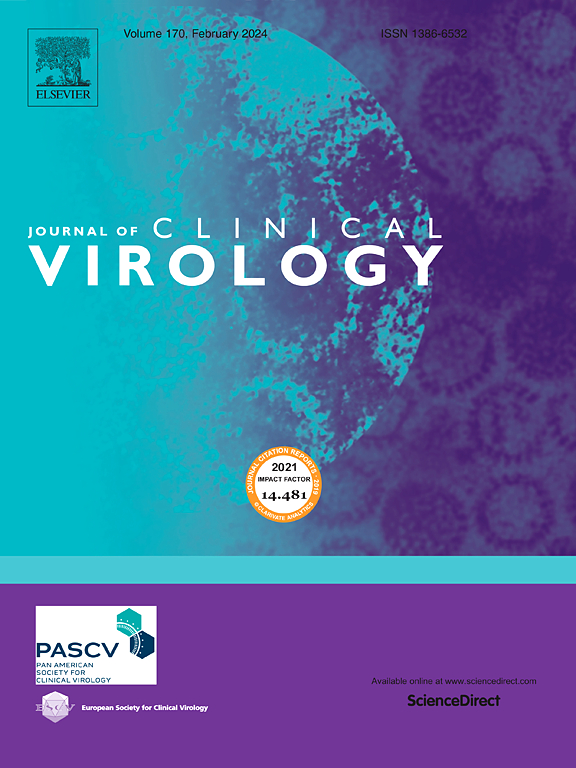人偏肺病毒的系统动力学和G基因变异进化中重复-缺失模型的证据
IF 3.4
3区 医学
Q2 VIROLOGY
引用次数: 0
摘要
2024年12月,随着中国医院病例的增加,人偏肺病毒(hMPV)引起了全球关注,促使世界卫生组织(WHO)发表声明,指出病例数仍在预期范围内。为了评估是否出现了一种公共卫生问题的变体,并检查全球hMPV系统动力学,我们在华盛顿州西部进行了一项基因组监测研究。研究设计:我们对2021年至2025年间在华盛顿州西部收集的住院和门诊患者的hMPV样本进行了基因组测序,并构建了系统基因组和系统动力学树。结果共获得60个hMPV-A基因组和39个hMPV-B基因组,其中13个来自2024年11月至2025年1月。在2019冠状病毒病大流行中断之后,hMPV季节性在2023年之后恢复到典型模式。基因组分析显示,自2022-23年以来hMPV-A优势,与A2b1, A2b2, B1和B2亚谱系共循环。A2b2亚系最为普遍,所有基因组都携带111-nt G基因重复。系统发育证据表明,111-nt变体是通过69-nt的缺失而不是通过独立的重复事件从先前的180-nt重复进化而来的。除A2b1外,大多数亚系表现为多个共循环分支。系统动力学表明,hMPV-A的进化速率高于hMPV-B,在大流行相关的下降之后,全球多样性恢复。没有发现明显的高度关注的进化特征。结论:尽管最近有一些担忧,但我们的研究结果表明,hMPV在美国的传播遵循预期的季节性模式,从先前存在的亚谱系中不断引入不同的病毒变体,而不是出现新的变体。持续的基因组监测至关重要,特别是随着疫苗开发的进展。本文章由计算机程序翻译,如有差异,请以英文原文为准。
Phylodynamics of human metapneumovirus and evidence for a duplication-deletion model in G gene variant evolution
Background
In December 2024, human metapneumovirus (hMPV) gained global attention amid rising cases in Chinese hospitals, prompting a World Health, Organization (WHO) statement indicating case numbers remained within expected ranges. To assess whether a variant of public health concern was emerging and to examine global hMPV phylodynamics, we conducted a genomic surveillance study in western Washington State.
Study design
We sequenced hMPV genomes from inpatient and outpatient samples collected between 2021 and 2025 in western Washington State and constructed phylogenomic and phylodynamic trees.
Results
We obtained 60 hMPV-A and 39 hMPV-B genomes, including 13 from November 2024 to January 2025. Following COVID-19 pandemic disruptions, hMPV seasonality returned to typical patterns after 2023. Genomic analysis showed hMPV-A predominance since 2022–23, with co-circulation of A2b1, A2b2, B1, and B2 sublineages. The A2b2 sublineage was most prevalent and all genomes carried a 111-nt G gene duplication. Phylogenetic evidence suggests the 111-nt variant evolved from a prior 180-nt duplication via a 69-nt deletion rather than through independent duplication events. Most sublineages showed multiple co-circulating clades, except A2b1. Phylodynamics showed recovery of global diversity after pandemic-related declines and a higher evolutionary rate in hMPV-A compared to hMPV-B. No distinct evolutionary features of heightened concern were detected.
Conclusions
Despite recent concerns, our findings indicate that hMPV circulation in, the USA follows expected seasonal patterns, with ongoing introductions of diverse viral variants from preexisting sublineages rather than emergence of a novel variant. Continued genomic surveillance is essential, particularly as vaccine development progresses.
求助全文
通过发布文献求助,成功后即可免费获取论文全文。
去求助
来源期刊

Journal of Clinical Virology
医学-病毒学
CiteScore
22.70
自引率
1.10%
发文量
149
审稿时长
24 days
期刊介绍:
The Journal of Clinical Virology, an esteemed international publication, serves as the official journal for both the Pan American Society for Clinical Virology and The European Society for Clinical Virology. Dedicated to advancing the understanding of human virology in clinical settings, the Journal of Clinical Virology focuses on disseminating research papers and reviews pertaining to the clinical aspects of virology. Its scope encompasses articles discussing diagnostic methodologies and virus-induced clinical conditions, with an emphasis on practicality and relevance to clinical practice.
The journal publishes on topics that include:
• new diagnostic technologies
• nucleic acid amplification and serologic testing
• targeted and metagenomic next-generation sequencing
• emerging pandemic viral threats
• respiratory viruses
• transplant viruses
• chronic viral infections
• cancer-associated viruses
• gastrointestinal viruses
• central nervous system viruses
• one health (excludes animal health)
 求助内容:
求助内容: 应助结果提醒方式:
应助结果提醒方式:


